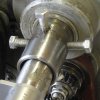After the recent thread, I figured many would enjoy seeing how brakes are installed. I'm installing one now. I'll offer some photos and explanations. If you have any questions, I'd be happy to answer.
For starters, here is a finished brake, blended and polished to match the factory Sendero barrel. I built this brake to suit the customers wants.
For starters, here is a finished brake, blended and polished to match the factory Sendero barrel. I built this brake to suit the customers wants.











